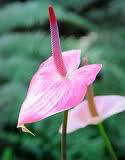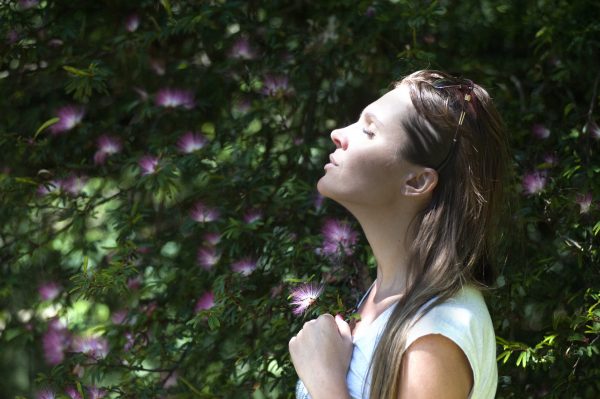 The eye-catching blooms of anthurium are mere modified leaves called spathes. But these spathes are not ordinary because they come in bright colors and are glossy in appearance. A pot of flowering anthurium costs P80 to 250 depending on the variety. Price of cut flowers vary with the size.
The eye-catching blooms of anthurium are mere modified leaves called spathes. But these spathes are not ordinary because they come in bright colors and are glossy in appearance. A pot of flowering anthurium costs P80 to 250 depending on the variety. Price of cut flowers vary with the size.
There are two types of anthurium, the foliages and the flowering type.
Propagation.
The suckers that have reached the 3 to 4 leaf stage any be separated from the mother plant and used as propagates (planting materials). If the cultivars do not produce suckers, the shoots produced by the remaining stump (a remnant, after the main part has been removed) may later be removed to produced more plants.
Anthurium can also be propagated by means of seeds. However, seeds take 6 to 7 months to ripen after fertilization and must be sown immediately. They germinate in 2 to 8 weeks. Since propagation by seeds is slow, they are often used with the newer hybrids to produce new plants types and not as means of mass propagating an existing cultivars.
Selecting planting medium.
Choose a medium that has a high organic matter content, good water holding capacity and yet, well-drained. Availability, cost aeration and drainage and handling ease should also be considered when choosing the medium. Coconut husk, wood chips, wood shavings, saw dust, sugar cane bagasse, coffee parchment and volcanic cinder are some of the media being used by our local growers. They can be used singly or in various combinations.
Planting practices.
Anthurium may be planted in raised beds with the use of volcanic cinder as drainage material. Add your choice of medium or media on the top and set the plants about one foot apart. You can also use clay pots (no. 10). Their size will depend on the size of the plants. Closer spacing may help produce the greatest number of flowers per unit area. Since Anthurium are shallow-rooted, they may need support when planted on raised beds.
A minimum of 4 leaves per plant necessary for the optimum growth of Anthurium. During summer months, water the plants frequently and less during the rainy season. Generally, Anthurium require a high humidity and above average amount of water.
Organic and inorganic fertilizers can be used but the amount varies depending on the media used, light conditions, and cultivars. You can apply urea on small seedlings to enhance growth. As for complete fertilizers, apply them at the rate of 10 grams per squire meter or one teaspoon per pot. Fertilizers are usually applied in liquid form. frequent application of fertilizers in diluted concentration is more beneficial to Anthurium than less frequent application using concentrated formulations. When available, one half to one cup of organic fertilizers can be applied to each plant.
Light is also important factor in anthurium production. The plants seem to grow best under 60 to 70 per cent shade during summer months. Wooden or bamboo slats, saran cloth, nylon fish nets, or live tree branches can be used as shade. But they be high enough to allow free circulation of air. Shading will prevent the leaves from yellowing and the blooms from being bleached which is caused by excessive sunlight.
Better quality flowers (in terms of substance and color intensity of the spathe) can be obtained under lower temperatures. However, very cool temperatures may lessen flower yield. The temperature range of Anthurium is between 18.3oC (night temperature) and about 26.7oC (day temperature).
Controlling pests and diseases.
Mites are the most commonly reported pests here in our country. They can be controlled with the use of chemicals like Kelthane, Azodrin and other miticides. Diseases like anthracnose and leaf spot may be controlled with clean culture and the use of fungicides. When some plants are infested with bacterial blight, remove and burn them.
Harvesting and grading.
The maturity indices used in harvesting anthuriums are the firmness of the peduncle and the degree of color change of the spandex. When the spathe unfurls, the spadix changes its color from the base to the tip within a period of 3 to 4 weeks. “Ozaki” flowers are harvested when the peduncle is turgid and the spathe’s glossiness is subdued, the proximal 1/8 of the spadix is white, ;and the forms approximately a 45 o angle with the spathe. Grades being used by the Hawaiian growers that may also be adopted. Here are:
Grade Average length and width of the spathe
Miniature under 3″
Small 3-4″
Medium 4-5″
Large 5-6″
Extra Large over 6″
Postharvest handling.
At room temperature, anthurium flowers may last for one to two weeks. Storage at 7.20oC or at lower temperature causes a darkening of the spathe . The optimum storage temperature is about 13.3oC.
Using the commercial flower preservatives can extend the vase life of anthurium flowers.
Evaluating and selecting cultivars.
Yield, flower quality, suckering ability, resistance to pests and diseases and superior postharvest handling characteristics are the plant traits that must be considered in selecting superior plant cultivars.
A minimum of 6 flowers per plant per year is acceptable for commercial cutflower production. The color of the flower should bright and uniform. A reclining spadix is advantageous during transport. It facilitates packaging of the flowers for shipment . The stem should be long enough and straight and carries the flower above the leaves. To adequately support the bloom, it should be medium to heavy in thickness.
A good commercial cultivars produces sucker freely. But too many suckers is an undesirable trait because it affects flower production. Also, a good cultivars must have high degree of resistance to principal pests and diseases prevalent in the plantation area. A relatively long vase life of flowers is also a good trait of cultivars.
Foliage type
A. warocqueanum
A. magnificum
A. crystallium
A. clarinervium
A. hookeri
A. veitchii
A. scandens
Flowering type
A. ornatum
A. scherzerianum
A. andreanum
And here’s some locally grown cultivars of A. andreanum
Nitta (orange ) Baguio White
Kaumana (red) (sometimes white
Kaonaiwan (white) with a light pink
Ozaki (light red to blush) pink)
Duang Smorn (red) Pink Exotica (pink)
Pink-a-dee-dee (pink)
Kanda (pink)
Source: http://dost.gov.ph
Photo: wikimedia.org




Recent Comments